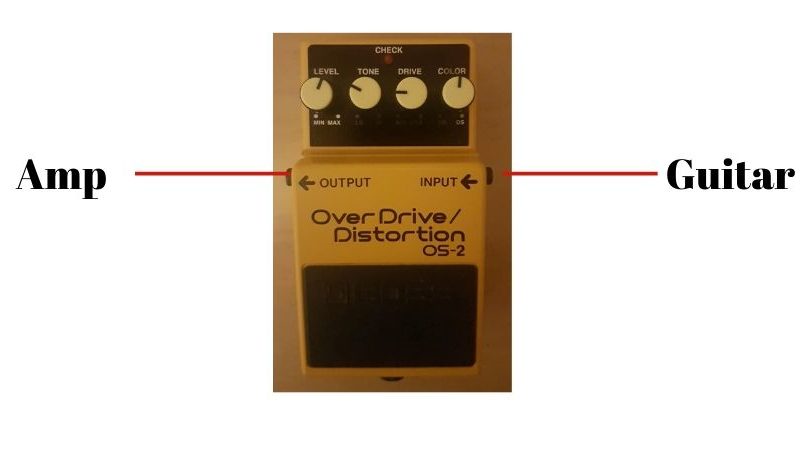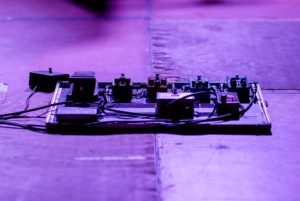If you’re new to guitar effects pedals, then you’re probably wondering how on earth you actually set them up and get started.
In this article, I’ll address all the main questions surrounding this issue so you can get playing as soon as possible. So let’s get started!
How to Connect your Pedals to your Guitar and Amp
In order to use guitar pedals properly, you need to connect them to both your amp and guitar.
Your pedals act as a centre point between your amp and guitar to ensure that your sound is modified before going into your amp and being played through the speakers.
What You’ll Need
To connect your pedals to your guitar and amp you’ll need two guitar amp cables.
Check out these Guitar Cables on Amazon for a high-quality but affordable option.
The Process
Here are the steps to get everything connected.
- Make sure your amp is turned off.
- Connect your guitar cable to your guitar.
- Then plug the other end into the “input” side of your pedal.
- Plug another guitar cable into the “output” side of your pedal.
- Then plug the other end into the “input” on your amp.

Connecting the pedals together is only half the battle. If you have multiple pedals, you need to make sure you get them in the right order. Check out my complete guide to pedal chain ordering to learn how to get the best tone.
How to Connect Pedals to Each Other
If you have multiple effects pedals that need connecting to your amp and guitar at a time, you’ll need to create a pedal chain.
The only extra thing you need to be able to connect more than one pedal, is a patch cable.
They’re small cables that are designed to connect your guitar pedals to one another. Then you connect the first pedal to your guitar as normal, and your last pedal to your amp. Then you form a pedal chain.
You can pick up these patch cables on Amazon for a great price.
They’re small so look neat as you don’t have loads of extra wire around your pedals.

Do I Need a Power Supply?
In order for your pedals to be able to switch on, you’ll need some form of power supply. There are three main methods you can use to power your pedals:
- 9V battery
- DC Power Supply and Daisy Chain
- Isolated Power Supply
Which method you should use, depends on the compatibility of your pedals.
Most full size pedals are battery operated so you can simply put a 9V battery in it, and off you go.
But if you have a mini version of a pedal, it most likely needs mains connection as it is too small to store a battery inside.
The best way to do this, is by using an adapter plug like this 9V DC Power Supply Adapter on Amazon.
If you need to connect multiple pedals to the mains, then you can use a cable splitter. This allows you to connect multiple pedals to the same adapter. Check out this Daisy Chain Cable Splitter on Amazon.
The final way, is to use a power supply, which means you don’t need a daisy chain splitter but you can connect your pedals to one device to power them all.
Something like the Voodoo Lab Pedal Power on Amazon is a good option. It has 5 outputs so you can connect 5 pedals and is a good option if you don’t want to get something really high-end.
An isolated power supply like this one will prevent humming and feedback issues which can arise when using a daisy chain.
I’ve written a full guide explaining the different kinds of power supplies you can use for guitar pedals so check it out if you want to find the best option for you.
What is a Pedal Board?
If you’re more serious about getting into guitar effects pedals, then you might want to look into getting a pedal board. There are several different types of pedal boards and they come in loads of different sizes.
Some pedal boards have a power supply which is great if you’re using mini pedals mainly, whereas others simply act as a place to store your pedals and keep them stable and neat when you’re playing.
How to choose a pedal board
The first thing you need to do when choosing a pedal board, is decide what size you need.
Think about how many pedals you own currently, and if you’re planning to purchase any more in the near future. Then whatever that number is, add room for a couple more pedals in case you want to add some more in the future.
Then, have a think about whether you need a power supply or not. I’d recommend getting one that either has a power supply, or adaptor to connect to your mains as it means you don’t have to keep replacing batteries, or using more wires and power packs.
Something like the Boss BCB-60 is a great option if you want to invest in a pedal board. It’s pretty lightweight and very well made with a padded interior. It comes with an AC adaptor so it can be connected to a power supply and has enough room for 7 devices.
You can check out the Boss BC-60 on Amazon.

Organising your new pedalboard? Check out my ultimate guide to designing a pedalboard including all the equipment you need and a step by step formula to getting set up in a pain-free way.
What's the Best Pedal Order?
If you’re interested in using multiple pedals, then you need to think about what order to put them in. The position of the pedals in the chain affects what kind of sound they produce.
Although there’s no rules when it comes to ordering your pedals, a lot of guitarists like the following chain order, so give it a try and then experiment yourself. It starts from the guitar end, and goes towards the amplifier.
- Tuner pedals: you want to be able to tune your guitar without any effects getting in the way.
- EQ pedals: you can put these early on to get the right balance of mids, treble and bass to play with later on by using more effects.
- Compressors: this allows you to alter the volume level of your guitar and smooth everything out so you don’t get unwanted changes caused by how heavy or light you pick.
- Distortion/ Overdrive/ Fuzz: putting these pedals here allows you to distort the tone of your guitar, before any more dramatic effects alter it like modulation, delay, reverb etc.
- Modulation pedals e.g. phaser, tremolo, chorus: these add more unique effects so should go towards the end of your chain.
- Time related pedals e.g. delay, reverb: putting these at the end avoids the echo effect being altered by any other effects.
Looking to get the best out of your pedals? Check out my full article on the best pedal chain order here to learn everything you need to know about setting up your chain.
So there you go! That’s how to connect your effects pedals to your guitar and amp! I hope you’ve found this article helpful, thanks for reading. Here are some other posts you might find useful:
